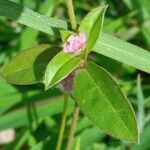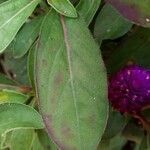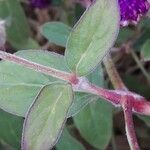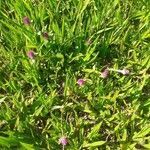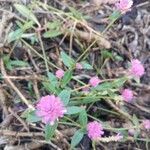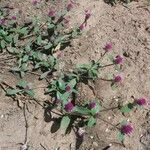Erect or ascending pilose annual herbs, the branching stems to 60 cm. high. Leaves sericeous, occasionally glabrate, oblong to ovate or obovate, apically acute and mucronate, basally rounded to attenuate, 2-10 cm. long, 0.5-5 cm. broad; petioles 1-15 mm. long. Inflorescences of terminal and axillary reniform to cylindric variously colored heads or spikes, occasionally clustered, 10-25 mm. long, 15-25 mm. broad, subtended by ovate leaves 5-20 mm. long. Flowers perfect; bracts persistent, ovate, acuminate, 3-4 mm. long; bracteoles dentate-cristate, exceeding the sepals, 7-12 mm. long, 2-3.5 mm. broad; sepals 5, subequal, basally connate, cinereous-to rufous-lanate, ultimately indurate and closely embracing the fruit, 5-6.5 mm. long; stamens 5, the anthers sessile between the 5 2-lobate pseudostaminodia; stamen tube 4-8 mnm. long; ovary globose; style 1, 1-1.5 mm. long; stigmata 2, 1-1.5 mm. long. Fruit an indehiscent areolate utricle 1.5-2.5 mm. long; seeds cochleate-orbiculate, reddish brown, ocellate, 1.5-2 mm. broad.
Annual, erect or at base decumbent and rooting, 15-60 cm high; stem thickened at base of internodes, often tinged with red, on young parts ap-pressed pilose. Leaves oblong or oblong-obovate from an acute base, obtuse, often ± undulate, thinly pilose on both surfaces, 5-15 by 2-6 cm; petiole 1-1½ cm; 2 topmost leaves sessile or nearly so. Heads sessile or subsessile above the topmost pair of leaves, solitary or sometimes in clusters of 2-4, globose or depressed globose, 1¾-2¼ cm diam.; bracts ovate-triangular, acuminate, acute, 3-6 mm; bracteoles with very distinct dentate-serrate dorsal crest, much surpassing the bract, 7-12 mm by 2-¾ mm (crest included), deep purple, pink or white. Perianth shorter than the bracteoles, yellowish green, white-woolly outside, 6-6½ mm long. Staminal tube about equalling the perianth; its lobes at least partly obtuse or rounded, not or hardly longer than unwithered anthers. Style much shorter than staminal tube, bifid. Fruit ovoid, ± 2½ mm; seed reniform, swollen.
Annual herb to 1 m or more; stem pubescent. Leaf-blade oblong, ovate or elliptical, to 11 x ca. 3.5 cm, apex obtuse, acute or acuminate, apiculate, base decurrent onto a short petiole, entire, pubescent, ciliate. Inflorescence of terminal and axillary, to ca. 15 cm long pedunculate, hemispherical or short-cylindrical heads; heads to 2.5 x ca. 2.5 cm; involucral leaves green, foliaceous, broadly ovate, to ca. 1 cm long, pubescent like cauline leaves; bracts ovate, 4-6 mm long, scarious, glabrous; bracteoles narrowly elliptical, 7-10 mm long, glabrous, strongly scarious-winged, irregularly jagged-denticulate, much longer than perianth. Flowers red, white, purplish-red, pink or yellow; tepals 5-6 mm, lanate with straw-colored, whitish, reddish or brownish hairs. Utricle ellipsoid, strongly apiculate into a to ca. 2 mm long beak; seed lenticular-ovoid, ca. 1.3 x 1 mm, rich brown or yellowish-brown, lustrous.
Herbs annual, erect, 20-60 cm tall. Stem stout, branched; branches slightly quadrangular, gray strigose, slightly inflated at nodes. Petiole 1-1.5 cm, long gray hairy; leaf blade oblong or oblong-obovate, 3.5-13 × 1.5-5 cm, papery, long white hairy and ciliate, narrowing toward base, margin undulate, apex acute or obtuse. Heads terminal, 1-3, usually purple, sometimes light purple or white, 2-2.5 cm in diam. Bracts 2, opposite, green, ovate or cordate, 1-1.5 cm, gray hairy; bracts white, purple at apex, ovate, 3-5 mm; bracteoles purple, triangular-lanceolate, much longer than bracts, 1-1.2 cm. Tepals not rigid after anthesis, lanceolate, 5-6 mm, outside densely white lanose, apex acuminate. Filaments connate into a tube, 5-parted at apex. Styles linear, shorter than tube of stamens; stigmas 2, furcate. Utricles subglobose, 2-2.5 mm in diam. Seeds brown, shiny, reniform. Fl. and fr. Jun-Sep.
Plants annual, not cespitose, 3-10 dm; roots fibrous. Stems erect, pilose-strigose. Leaves: petiole 0.5-2 cm; blade green, oblong to ovate, 2-10 × 0.5-5 cm, apex acute, villous. Inflorescences: heads white, yellow, red, or purple, globose, 20-28 mm diam.; bractlets crested along keel. Flowers: tube densely lanate; perianth lobes white to pink, lance-subulate, 4.4-5.2 mm, chartaceous, apex acuminate. Utricles oblong, 2 mm, apex acute. Seeds 1.5 mm.
Inflorescences sessile above the uppermost pair of leaves, usually solitary, globose or depressed-globose, c. 2 cm. in diam., pinkish to deep red; bracts deltoid-ovate, 3–5 mm. long, mucronate with the shortly excurrent midrib; bracteoles strongly laterally compressed, navicular, c.8–12 mm., mucronate with the excurrent midrib, furnished from the apex almost to the base of the dorsal surface of the midrib with a broad, irregularly dentate crest.
An upright bushy annual herb. Plants grow 30-60 cm high and spread to 30 cm across. Plants can lay over and root along the nodes. The leaves are oval and 15 cm long. They grow in pairs along the stem. They are covered with dense white hairs when young. The flower heads are oval and 3.5 cm long. They can be pink, red, purple or white flower bracts.
Leaves broadly lanceolate to oblong or elliptic-oblong, 2.5–12 (15) × 2–4 (6) cm., narrowed to an ill-defined petiole below, thinly pilose on both surfaces, the pair of leaves subtending the terminal inflorescence sessile or almost so, broadly to subcordate-ovate.
Annual herb, decumbent or erect, branched from the base and also above, c. 15–60 cm.; stem and branches striate or sulcate, more or less densely clothed with appressed white hairs at least when young.
Herb, up to 300 mm tall. Stems erect with white silky hairs. Leaves obovate-lanceolate. Inflorescences terminal, globose. Flowers purple-magenta.
Tepals similar to those of G. celosioides but longer (6–6.5 mm.), the outer more lanate and the inner less markedly indurate at the base.
Staminal tube subequalling the perianth, the 5 teeth deeply bilobed with obtuse lobes subequalling the anthers; pseudostaminodes absent.
A branching annual to 1 m, with terminal, colored heads 2–2.5 cm thick, and with very woolly fls, occasionally escapes from cult.
Style and stigmas together c. 2.5 mm. long, stigmas divergent, subequalling or slightly longer than the style.
Seeds compressed-ovoid, c. 2 mm. in diam., brown, almost smooth, shining.
A native of S. America, cultivated as an ornamental, also subspontaneous.
Capsule oblong-ovoid, compressed, c. 2.5 mm. long.
